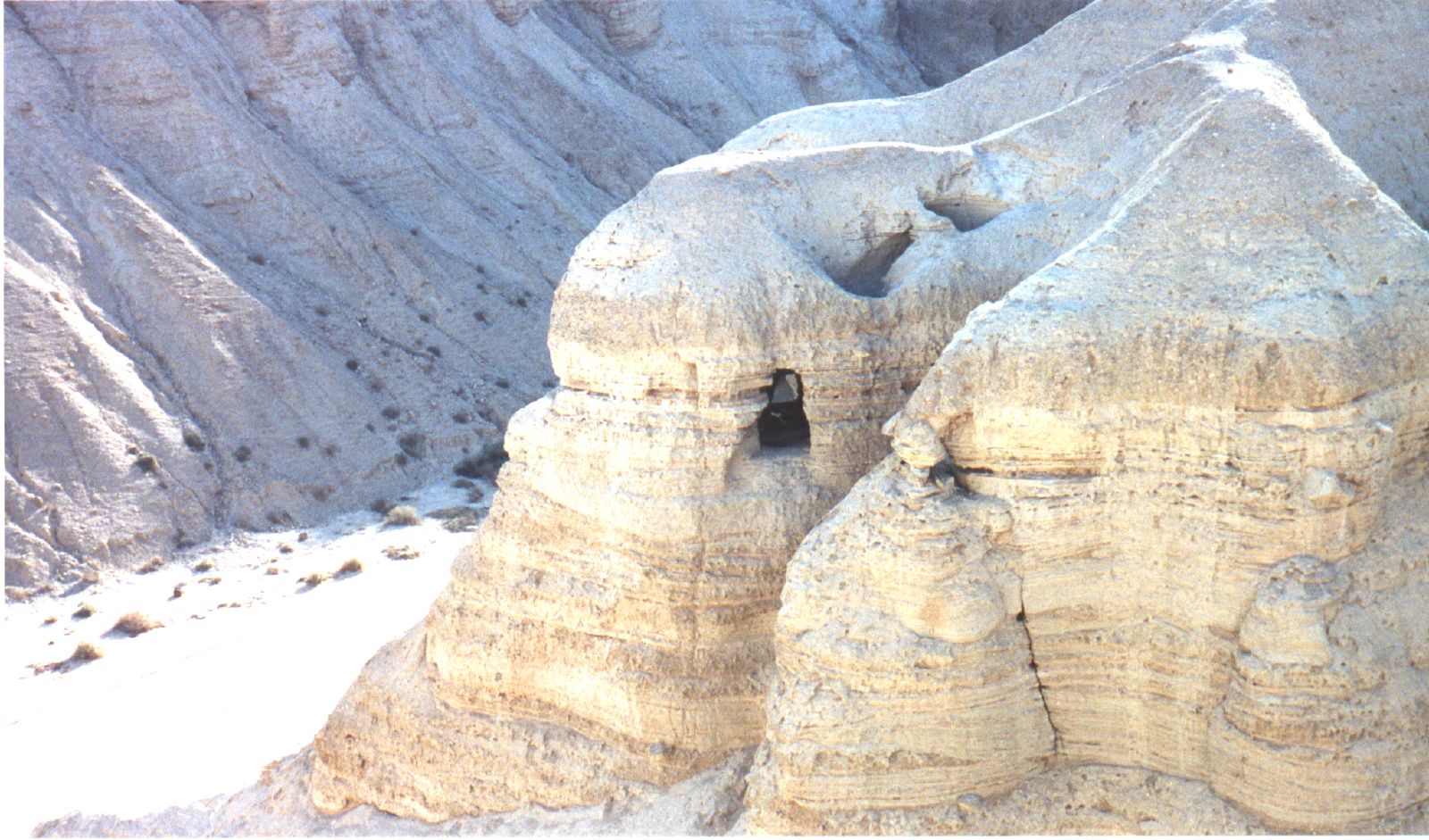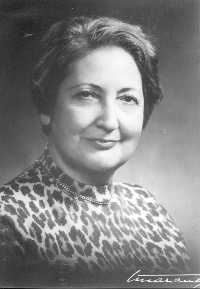 |
 |
 |
 |
  image
from Wikimedia image
from Wikimedia
The
caves of the discovery
The Dead Sea Scrolls are a collection of 972 texts from the Hebrew
Bible found in the 1940s at Khirbet Qumran on the northwest shore of
the Dead Sea from which it derives its name.
The texts are of great mystical and historical significance, as they
include the oldest known surviving copies and extra-biblical documents
and preserve evidence of great diversity in late Second Temple Judaism.
They are written in Hebrew, Aramaic and Greek, mostly on parchment, but
with some written on papyrus. These manuscripts generally date between
150 BCE and 70 CE.
The scrolls are traditionally identified with the ancient Jewish sect
called the Essenes, though some recent interpretations have challenged
this association and argue that the scrolls were penned by priests in
Jerusalem, Zadokites, or other unknown Jewish groups.[3][4]
The Dead Sea Scrolls are traditionally divided into three groups:
"Biblical" manuscripts (copies of texts from the Hebrew Bible), which
comprise roughly 40% of the identified scrolls; "Apocryphal" or
"Pseudepigraphical" manuscripts (known documents from the Second Temple
Period like Enoch, Jubilees, Tobit, Sirach, non-canonical psalms, etc.,
that were not ultimately canonized in the Hebrew Bible), which comprise
roughly 30% of the identified scrolls; and "Sectarian" manuscripts
(previously unknown documents that speak to the rules and beliefs of a
particular group or groups within greater Judaism) like the Community
Rule, War Scroll, Pesher on Habakkuk (Hebrew pesher פשר =
"Commentary"), and the Rule of the Blessing, which comprise roughly 30%
of the identified scrolls.
Click here
to connect with me for discussing that on my personal Facebook space,
or here
to
visit my Fan page...
|
 |
 |
 |
 |
 |
 |
 |
 |
|
 |
|
 |
 |
 |
 |
 |
  image
from http://www.rakkav.com image
from http://www.rakkav.com
Madame
Suzanne Haik-Vantura
Mme. Haïk-Vantoura (née Vantoura) was a composer, organist and music
theoretician. Born in Paris, France in 1912, she entered the
Conservatoire National Superieur de Musique in Paris (CNSM) in 1931,
and was awarded First Prize in Harmony (1934), First Prize in Fugue
(1938), and Honorable Mention in Composition (1939). She became the
student of the great organist and composer Marcel Dupré from 1941 to
1946, then devoted herself to music composition and teaching.
World War II interrupted her studies, and she fled with her family to
southern France. While in hiding from the Nazis, then-Mlle. Vantoura
first approached a problem that had intrigued her since childhood: the
original meaning of the te`amim. By her account, she had learned in a
French encyclopedia of music that these signs were ancient, musical and
of unknown meaning. Given the lack of correlation between the melodies
of the synagogue communities and the physical features of the notation
itself, this appraisal was both plausible and objective -- and it
became the starting point in Mlle. Vantoura's research.
Read more...
Click here
to connect with me for discussing that on my personal Facebook space,
or here
to
visit my Fan page...
|
 |
 |
 |
 |
 |
 |
 |
 |
|
 |
 |
 |
 |
Some interesting search results:
Dead Sea scrolls - CreationWiki, the encyclopedia
of creation science
http://creationwiki.org/Dead_Sea_scrolls
The Dead Sea Scrolls are dated as far back as 3rd century before the
common era all the way to the 1st century of the common era. The
scrolls are what contain some of the oldest biblical books we know of.
The Dead Sea Scrolls are made up of 900 pieces of writing, and were
composed by a few different people or groups. We know of the Jewish
sectarians, and that they wrote some. The Essene sect is also thought
to have written some. The Essene sect was a group of Jews who left
Judaism and moved to the desert. We also know that some of the Scrolls
came from unknown sources as well.
Time Line of Early Christianity--The Lost Gospel of
Judas--National Geographic
http://www.nationalgeographic.com/lostgospel/timeline_19.html
The Dead Sea scrolls are one of the greatest discoveries in
archaeological history. The ancient texts first came to light in 1947,
when a young goat herder stumbled upon some manuscripts hidden in a
cave at Khirbat Qumran--about a dozen miles (19 kilometers) from the
ancient West Bank city of Jericho.
The Dead Sea Scrolls: A New Translation - Logos Bible
Software
http://www.logos.com/product/8868/the-dead-sea-scrolls-a-new-translation
The Dead Sea Scrolls are not just for scholars anymore. They are here
in a book that anyone can understand. Read these texts. Hidden in their
caves, they survived the ravages of time and decay to speak to us today
across two thousand years. They have survived their authors and will
survive us, their readers.
Importance of the Dead Sea Scrolls | eHow.com
http://www.ehow.com/about_6607991_importance-dead-sea-scrolls.html
The Dead Sea Scrolls are most significant because they are the oldest
copies of the Hebrew Bible. Before the discovery of the Dead Seas
Scrolls, the oldest copy of the Hebrew Bible was the Leningrad Codex,
dating to 1008 CE. The documents that comprise the Dead Sea Scrolls, on
the other hand, can be dated between 135 CE and 250 BCE, making these
documents roughly 1,000 years older than any other copies in existence.
The Dead Sea Scrolls are a collection of thousands of documents written
on parchment in Hebrew, Aramaic and Greek. While more than 800 of these
documents are complete, or almost complete, there are tens of thousands
of fragments. The documents in this collection include every book of
the Hebrew Bible, or Old Testament, except the book of Esther, as well
as many unique works.
Dead Sea Scrolls ? fragments of history :: The Valley
News
http://www.myvalleynews.com/story/24476/
The Dead Sea Scrolls are not only a significant archeological find, but
are also of great spiritual importance to those of both the Jewish and
Christian faiths. Twenty-seven scrolls, ten of which are on exhibit for
the first time, are on display at the San Diego Museum of Natural
History through the month of December. According to a museum employee,
the scrolls had their own seats on an airplane ? and were flown from
Israel highly guarded and shrouded in secrecy.
Evidence For The Bible -- The Dead Sea Scrolls | The
Bridge to Grace
http://thebridgetograce.com/2010/10/16/dss/
The Great Isaiah Scroll from the Dead Sea Scrolls are now housed
in the Shrine of the Book Museum in Jerusalem with other Hebrew
manuscripts of the Bible, while others are housed in numerous
universities in the U.S. These scrolls prove to be the exact words that
were written from before Jesus was born. Again, the only differences
are misspellings, grammar and punctuation.
What were the dead sea scrolls? - Yahoo! UK &
Ireland Answers
http://uk.answers.yahoo.com/question/index?qid=20101127054430AApUSUm
The texts are of great religious and historical significance, as they
include the oldest known surviving copies of Biblical and
extra-biblical documents and preserve evidence of great diversity in
late Second Temple Judaism. They are written in Hebrew, Aramaic and
Greek, mostly on parchment, but with some written on papyrus.These
manuscripts generally date between 150 BCE and 70 CE.The scrolls are
traditionally identified with the ancient Jewish sect called the
Essenes, though some recent interpretations have challenged this
association and argue that the scrolls were penned by priests in
Jerusalem, Zadokites, or other unknown Jewish groups.
|
|
 |
 |
 |
 |
 |
 |
 |
 |
 |
 |
 |
 Mehmet Okonsar is a
pianist-composer-conductor and musicologist. Besides his international
concert carrier he is a prolific writer. He is the founder of the
first classical music-musicology dedicated blog site: "inventor-musicae"
as well as the first classical-music video portal : http://www.classicalvideos.net.
Mehmet Okonsar's official site: http://www.okonsar.com Mehmet Okonsar is a
pianist-composer-conductor and musicologist. Besides his international
concert carrier he is a prolific writer. He is the founder of the
first classical music-musicology dedicated blog site: "inventor-musicae"
as well as the first classical-music video portal : http://www.classicalvideos.net.
Mehmet Okonsar's official site: http://www.okonsar.com |
 |
 |
 |
 |
 |
 |
 |
 |
 |
 |
 |
 |
 Inspiration By
Tzvi Freeman Inspiration By
Tzvi Freeman
There is nothing more bizarre: G-d tells us He despises idols -- and He
wants us to despise them, as well. He says, "Don't even think of making
idols. If idols come to your hands, burn them, destroy them, uproot
them. Give your lives rather than give any credence to those idols."
Then, in the innermost chamber of His temple, the place He calls "Holy
of Holies," there He tells us to make two golden figurines with wings,
one a male, the other a female. [read more...]
|
 |
 |
 |
 |
 |
 |
 |
 |
 |
 |
 |
 |
 People seem to enjoy things more when they
know a lot of other people have been left out of the pleasure. Russell
Baker (1925 - ) People seem to enjoy things more when they
know a lot of other people have been left out of the pleasure. Russell
Baker (1925 - ) |
 |
 |
 |
 |
 |
 |
 |
 |
This email is sent by me, Mehmet Okonsar (mehmet@okonsar.com)
The company Streamsend
is in charge of delivering my emails.
My street address is: Mesnevi S. 46/15 TR-06690 Ankara - Turkey
Phone: + 90 312 438 0917 - GSM: + 90 533 767 1899
|
|